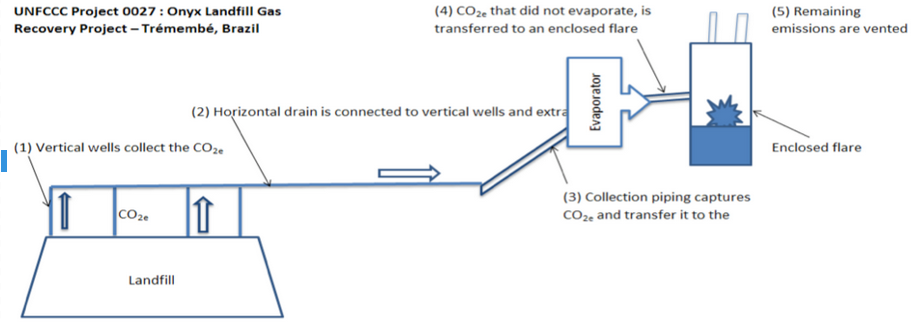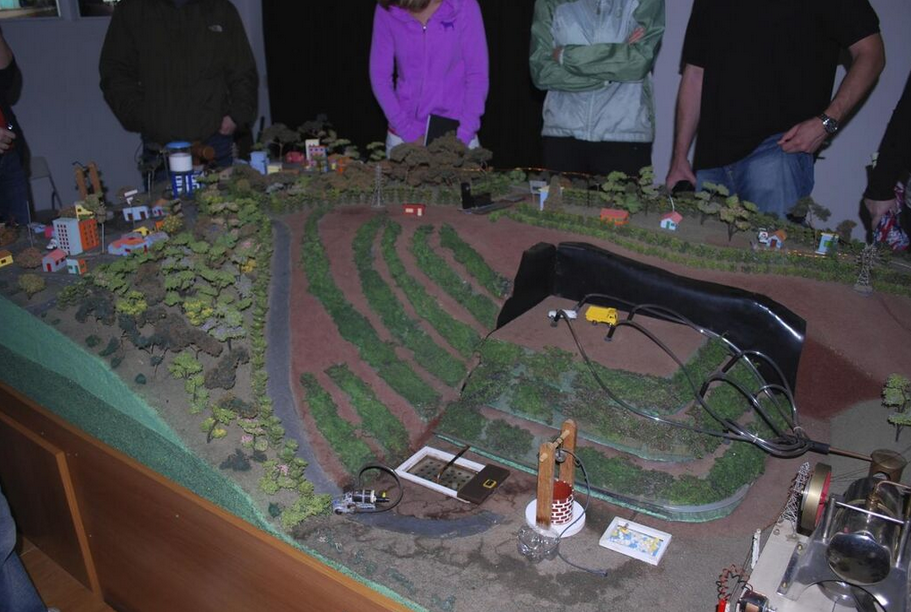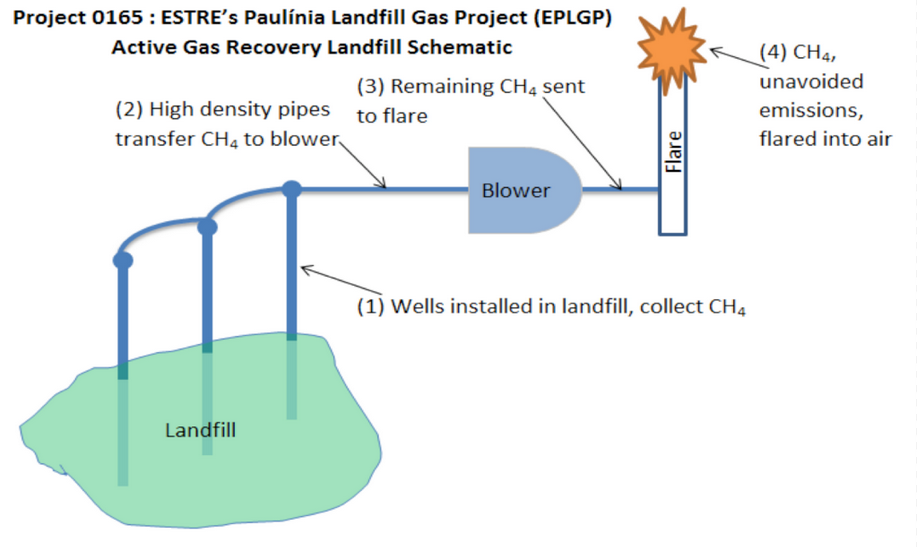
| Version | Summary | Created by | Modification | Content Size | Created at | Operation |
|---|---|---|---|---|---|---|
| 1 | Beatrix Zheng | -- | 1765 | 2022-11-10 01:49:53 |
Video Upload Options
Brazil has established a strong public policy using Clean Development Mechanism Projects to reduce methane emissions from landfills. An important component of these projects is the sale of avoided emissions by the private market to generate revenue.
1. Introduction
Faced with serious pollution challenges, Brazil established public policy that would create incentives for the foreign and national private market to invest financial, technological, and human resources in the country. The premise is that experienced companies would bring their technology to Brazil, in an effort to reduce methane gas emissions. The specific technology and projects discussed in this article refer to landfill gas projects. Although this technology was new to Brazil in the early 2000s when companies first began implementing them, these methods were not new to Europe or North America. Additionally, Brazil is just one of many countries participating in similar projects around the world.
2. Background
Brazil signed the Kyoto Protocol on April 29, 1998 and ratified it on August 23, 2002.[1][2] To date, Brazil has 347 clean development mechanism (CDM) projects, which account for 7.3% of the total projects worldwide.[3] Estimated projections by the United Nations Environment Programme (UNEP) show that by 2012, Brazil will have 102 million certified emission reductions (CER), a $1,225 million value. Unlike its fellow BRIC countries, in Brazil the largest component of potential CER projects is landfill gas projects, with a 31.3% share.[3] According to the national survey on basic sanitation (PNSB) conducted in 2008, all of the 5,564 municipalities have access to basic sanitation.[4] According to the Environmental Sanitation Technology Company (CETESB) study, the 6,000 waste sites in Brazil receive 60,000 tonnes of waste per day. Seventy-six percent (76%) of this waste goes to dumps with no management, gas collection, or water treatment. This same study showed that 83.18% of Brazil's methane gas emissions come from uncontrolled waste sites.[5]
3. Landfill Gas Projects
Private companies have submitted CDM projects to the United Nations Framework Convention on Climate Change (UNFCCC) to use landfill gas (LFG) discharges from waste management sites to earn carbon credits or CER. There are over 100 LFG CDM projects in Brazil.[3] The diagram below illustrates the process.[6]

First, once the waste management company has developed the landfill with the new technology, (1a) it calculates how much methane (CH4) would have been emitted into the air without its intervention. (1b) Then it converts the CH4 into carbon equivalents (C02e). (2a) Next, the company projects how much methane it expects to emit into the air, with the new technology. Again, (2b) it converts the CH4 into C02e. (3) Next, the company determines the avoided emissions or CER but subtracting the emission projections with the technology from the baseline emissions without the technology. (4) Once credited, the company sells the CER through a broker to companies that will produce emissions greater than their allotted capacity.
3.1. SASA
The SASA[7] landfill is located in Tremembé in São Paulo State of Brazil. Onyx SASA is a subsidiary of Veolia Environnement and is an officially registered project with UNFCCC, as of November 24, 2005. SenterNovem, an agency of the Dutch Ministry of Economic Affairs in the Netherlands, is a partner in the project. The following flow chart depicts the process used by the landfill:

Landfill Gas Clean Development Mechanism Monitoring System. https://handwiki.org/wiki/index.php?curid=1885151
(1) Methane (CH4) or carbon equivalents (CO2e) are captured by the vertical wells. (2) Next, a horizontal drain that is connected to the vertical wells extracts the CO2e. (3) Then, a high density collection pipe captures the CO2e and transfers it to the evaporator. (4) Any CO2e that did not evaporate, is transferred to an enclosed flare. (5) The remaining emissions are then vented into the air.
At the filing of the report, Onyx SASA anticipated the landfill would accrue 700,625 tons CO2e from 2003 through 2012 in CER. As of 2011, Onyx SASA has filed monitoring reports for the periods of 2003 through 2007. The following chart outlines the actual CER realized to date:
| Year | Baseline CO2e Emissions |
CO2e Emissions with CDM Technology |
Projected CER | Actual CER |
|---|---|---|---|---|
| 2003 | 57,093 | 20,433 | 36,661 | 21,954 |
| 2004 | 71,350 | 26,083 | 45,267 | 30,656 |
| 2005 | 85,147 | 37,383 | 47,764 | 40,988 |
| 2006 | 98,024 | 36,617 | 58,407 | 46,030 |
| 2007 | 109,719 | 38,566 | 71,153 | 42,320 |
| 2008 | 120,362 | 49,932 | 70,430 | TBD |
| 2009 | 129,889 | 39,551 | 90,338 | TBD |
| 2010 | 138,233 | 48,158 | 90,075 | TBD |
| 2011 | 145,394 | 57,947 | 87,447 | TBD |
| 2012 | 149,730 | 46,647 | 103,083 | TBD |
| Total | 1,104,943 | 404,318 | 700,625 | 181,948 (2003–2007) |
Additionally, the project design report states Onyx SASA expects to revegetate and reforest the land; upon fulfillment, 150,000 trees will be planted around the landfill.
3.2. Paulínia

Empresa de Saneamento e Tratamento de Resíduos (ESTRE)[8] is a private waste management Brazilian-based company, founded in 1999. ESTRE operates seven sites in Brazil, Uruguay, and Argentina. It offers waste management services, including recycling and landfills, to private companies and the government.[9] The Paulínia Landfill Gas Project (EPLGP) is located in Campinas in São Paulo State of Brazil. The project was registered on March 3, 2006 with UNFCCC.
The goal of the EPLGP is to reduce greenhouse emissions. The following schematic illustrates the process of capturing and recycling the gas emissions:

Active Gas Recovery Landfill. https://handwiki.org/wiki/index.php?curid=1833963
As illustrated above, (1) wells installed in the landfill collect the methane (CH4). (2) Next, high density pipes connected to the wells transfer the CH4 to the blower. (3) Any remaining CH4 is then sent to the flare. (4) Last, the CH4 is flared into the air.
The following table outlines the forecasted and actual yearly outputs of CER according to the monitoring reports filed with UNFCCC:
| Timeframe | Projected CER | Actual CER |
|---|---|---|
| 9/14/2006 - 1/31/2007 | 67,179 | 56,376 |
| 2/1/2007 - 7/31/2007 | 96,268 | 81,862 |
| 8/1/2007 - 2/29/2008 | 116,745 | 112,938 |
| 3/1/2008 - 8/31/2008 | 91,873 | 104,918 |
| 2/1/2009 - 6/30/2009 | 96,549 | 112,950 |
| 7/1/2009 - 2/25/2010 | 157,089 | 177,545 |
| 2/26/2010 - 7/31/2010 | 70,832 | 187,909^ |
| 8/1/2010 - 10/31/2010 | 63,505 | 118,860^ |
| 11/1/2010 - 1/31/2011 | 61,077 | 119,056^ |
| 2/1/2011 - 12/31/2011 | 204,397 | TBD |
| 2012 | 198,019 | TBD |
| Total | 1,487,908 | 1,188,640 (9/14/2006 - 1/31/2011) |
^The notable increase in actual CER versus the projected CER is due to the increase in waste received by the landfill, from 2.5 tons per day as reported in the CDM application to 5 tons per day.
4. Legislation: National Policy on Climate Change
After Brazil's Congress passed the climate change legislation, on December 29, 2009, President Luiz Inácio Lula da Silva signed the National Policy on Climate Change (PNMC).[10] The law requires Brazil to reduce greenhouse gas emissions by 38.9% by 2020.[10][11] On December 9, 2010 President Lula signed a decree which details the provisions of PNMC.[12] At its foundation, PNMC focuses on prevention, citizen participation, and sustainable development.[13][14]
4.1. Law N° 12.187 of 2009
There are 13 articles in the legislation:[10]
- Article 1 establishes the laws and principals governing PNMC.
- Article 2 establishes definitions and key terms related to climate change including, adverse effects of climate change, emissions, greenhouse gases, and mitigation.
- Article 3 states:
- Everyone has a duty to reduce the human impact on climate change
- Steps will be taken to anticipate, prevent, and minimize the causes of climate change as determined by the scientific community
- Measures will be taken to consider and distribute the burden among various socio-economic populations and communities
- Sustainable development is a prerequisite for mitigating climate change and the needs of each population and territory should be dually considered
- Actions taken at the national level to mitigate climate change must consider actions taken at the municipal, state, and private sectors
- Vetoed
- Article 4 outlines the goals:
- Reconcile socio-economic development and climate protection
- Reduce greenhouse emissions
- Vetoed
- Strengthen methods for removal of anthropogenic green house emissions
- Use measures to promote adaption by all three spheres of the Brazilian Federation with participation and collaboration from economic and social sectors, in particular those most affected by climate change
- Preserve, conserve, and restore environmental resources, in particular natural biomes considered a National Heritage
- Consolidate and expand legally protected areas and encourage reforestation and revegetation of degraded areas
- Stimulate development of the Brazilian Market for Emissions Reduction (MBRE)
- Article 5 establishes the guidelines of PNMC:
- Follow-through on commitments made through the Kyoto Protocol and other climate change measures
- Assess measurable benefits, quantifiable and verifiable, of mitigation actions
- Adapt measures to reduce adverse effects
- Integrate strategies at the local, regional, and national levels
- Encourage participation of the federal, state, county, and municipal levels, as well as the productive sector, academia and civil society organizations, and implement policies, plans, programs, and actions
- Promote and develop scientific research
- Utilize financial and economic instruments to promote mitigation actions
- Identify and articulate the instruments used to protect climate change
- Promote activities that effectively reduce gas emissions
- Promote international cooperation
- Improve systematic observation
- Promote dissemination of information, education, and training
- Stimulate and support practices and activities with low emissions and sustainable consumption
- Article 6 outlines the instruments, committees, plans, funding, policy, research, monitoring, indicators, and assessments PNMC will utilize toward climate change.
- Article 7 outlines institutional instruments PNMC will utilize:
- Interministerial Committee on Climate Change
- Interministerial Commission on Global Climate Change
- Brazilian Forum on Climate Change
- The Brazilian Network for Research on Global Climate Change - Climate Network
- Commission for Coordination of Activities of Meteorology, Climatology and Hydrology
- Article 8 addresses the official financial institutions line of credit to support climate change efforts.
- Article 9 notes that MBRE will be monitored by the Securities Commission.
- Article 10 was vetoed.
- Article 11 states that public policy and government programs should be compatible with PNMC.
- Article 12 states the country's adoption of greenhouse emission gas reductions of 36.1% to 38.9%.
- Article 13 states that the law will become official on its publication date of December 31, 2009.
4.2. Presidential decree N° 7.390 of 2010
The decree specifies how Brazil quantifies greenhouse emissions, how it will achieve the reduction, and a legal requirement for estimating annual emissions. The policy will use Brazil's 2005 emission rate as the business as usual base line for comparison of future emissions. The Policy:[12][15]
- Provides authority for adopting mitigation actions to achieve the reduction goal
- Requires reduction efforts to be compatible with sustainable development and economic and social interests
- Designates instruments for implementation, include the National Climate Change Plan and the National Climate Change Fund
- Establishes sectoral plans for mitigation and adaptation in forests, agriculture, energy, and transportation
- Creates the Brazilian Market for Emissions Reductions (MBRE) for trading in avoided emissions certificates
Specifically, the decree lists the following Action Plans:[12]
- Prevention and Control of Deforestation in the Amazon
- Prevention and Control of Deforestation and Forest Fires in the Cerrado
- Ten Year Plan for Expansion of Energy
- Consolidation of an Economy of Low-Carbon in Agriculture
- Reducing Emissions from Steel
Per the decree, the Sectoral Plans will include:[12]
- Emission reduction target in 2020 and incremental goals with a maximum interval of three years
- Actions to be implemented
- Definition of indicators for monitoring and evaluating effectiveness
- Proposed regulatory instruments and incentives for implementation
- Competitive alignment with industry studies' estimated costs and impacts
Per the decree, the following sectors are included in the estimations:[12]
- Change of Land Use: 1,404 million tons of CO2e (e=equivalent)
- Energy: 868 million tons of CO2e
- Agriculture: 730 million tons of CO2e
- Industrial Processes and Waste: 234 million tons of CO2e
The National Climate Change Fund "supports mitigation and adaptation projects and will rely principally on a to-be-determined portion of future oil and gas revenues."[12][15]
References
- "Kyoto Protocol Status of Ratification (pdf)" (PDF). http://unfccc.int/files/essential_background/kyoto_protocol/status_of_ratification/application/pdf/kpstats.pdf. Retrieved March 5, 2011.
- "Status of Ratification". UNFCCC's Kyoto Protocol Background. http://unfccc.int/kyoto_protocol/background/status_of_ratification/items/2613.php. Retrieved March 5, 2011.
- Raghavan, P. (December 9, 2009). "China, India and Brazil ahead in carbon credits". The Financial Express. http://www.financialexpress.com/news/china-india-and-brazil-ahead-in-carbon-credits/551570/0. Retrieved March 5, 2011.
- "Pesquisa Nacional de Saneamento Basico (PNSB)" (in Portuguese) (PDF). Instituto Brasileiro de Geografia e Estatistica (IBGE). 2010. Archived from the original on April 13, 2015. https://web.archive.org/web/20150413211858/http://www.ibge.gov.br/home/estatistica/populacao/condicaodevida/pnsb2008/PNSB_2008.pdf. Retrieved March 6, 2011.
- "Methane Emissions From Waste Treatment and Disposal" (PDF). First Brazilian Inventory of Anthropogenic Greenhouse Gas Emissions Background Report. Environmental Sanitation Technology Company (CETESB), Ministry of Science and Technology, Brazil. 2002. http://homologa.ambiente.sp.gov.br/biogas/docs/relatorios_referencias/tratamento_de_residuos/rr_90_94_ingles.pdf. Retrieved March 28, 2011.
- "Landfill Gas (LFG) Study" (PDF). Global Environment Centre Foundation. c. 2000. http://gec.jp/gec/en/Activities/cdm/FS200304SE.pdf. Retrieved March 6, 2011.
- "Project 0027 : Onyx Landfill Gas Recovery Project – Trémembé, Brazil". ONYX / UNFCCC. October 2004. http://cdm.unfccc.int/Projects/DB/DNV-CUK1126082019.35/view. Retrieved March 7, 2011.
- "Project 0165 : ESTRE’s Paulínia Landfill Gas Project (EPLGP)". Empresa de Saneamento e Tratamento de Resíduos (ESTRE). July 1, 2004. http://cdm.unfccc.int/Projects/DB/DNV-CUK1134989999.25/view. Retrieved March 24, 2011.
- "Estre Company Website". http://www.estre.com.br/us/index.html. Retrieved March 31, 2011.
- "National Climate Change Policy" (in Portuguese) (PDF). Diário Oficial da União. December 29, 2009. http://www.glin.gov/view.action?searchDetails.issuanceDateFromyear=&searchDetails.searchAll=true&searchDetails.issuanceDateToday=01&searchDetails.includeAllFields=true&searchDetails.sortOrder=default&searchDetails.issuanceDateFrom=&search=Search&searchDetails.queryString=&popupSearch=false&fieldName=&searchDetails.queryType=BOOLEAN&searchDetails.andSubjectTerms=false&searchDetails.publicationLanguage=&searchDetails.publicationJurisdictionExclude=false&searchDetails.publicationDateFromday=01&searchDetails.publicationDateToday=31&searchDetails.issuanceDateToyear=&searchDetails.subjectTerms=&searchDetails.publicationDateFrom=01%2F12%2F2009&searchDetails.issuanceDateTo=&searchDetails.issuanceDateFromday=01&searchDetails.publicationDateFromyear=2009&__checkbox_searchDetails.showSummary=true&newSubjectTerm=&searchDetails.hitsPerPage=10&searchDetails.publicationDateToyear=2009&month=12&month=12&month=01&month=01&searchDetails.summaryLanguage=%27%27&searchDetails.publicationJurisdiction=30&searchDetails.publicationDateTo=31%2F12%2F2009&searchDetails.showSummary=true&glinID=232339&summaryLang=en&fromSearch=true. Retrieved March 22, 2011.
- Gonçalves, Alexandre (December 31, 2009). "Lula sanciona lei que cria política de mudanças climáticas" (in Portuguese). Grupo Estado. http://www.estadao.com.br/noticias/geral,lula-sanciona-lei-que-cria-politica-de-mudancas-climaticas,488389,0.htm. Retrieved March 5, 2011.
- Luiz Inácio Lula da Silva; Guido Mantega, Wagner Gonçalves Rossi, Miguel Jorge, Márcio Pereira Zimmermann, Sergio Machado Rezende, Izabella Mônica Vieira Teixeira (December 9, 2010). "Presidential Decree N 7.390" (in Portuguese) (Web). Brazil Federal Senate, Secretariat of Information. http://www6.senado.gov.br/legislacao/ListaPublicacoes.action?id=263075&tipoDocumento=DEC&tipoTexto=PUB. Retrieved March 22, 2011.
- Ministério do Meio Ambiente (December 15, 2010). "New decree details Brazil's National Policy on Climate Change". Amigos da Terra - Amazônia Brasileira. http://www.amazonia.org.br/english/noticias/noticia.cfm?id=373875. Retrieved March 5, 2011.
- Alexandre Leite Ribeiro do Valle and Carolina Pett G. Gonçalves (Summer 2010). "Brazilian Laws and Climate Changes". ABA International Law News. http://vmladvogados.wordpress.com/2010/08/28/brazilian-laws-and-climate-changes/. Retrieved March 5, 2011.
- Brazilian Embassy (December 9, 2010). "Incorporating Climate Change Policy into Domestic Legislation". http://www.wikileaks.ch/cable/2010/02/10BRASILIA140.html. Retrieved March 5, 2011.




